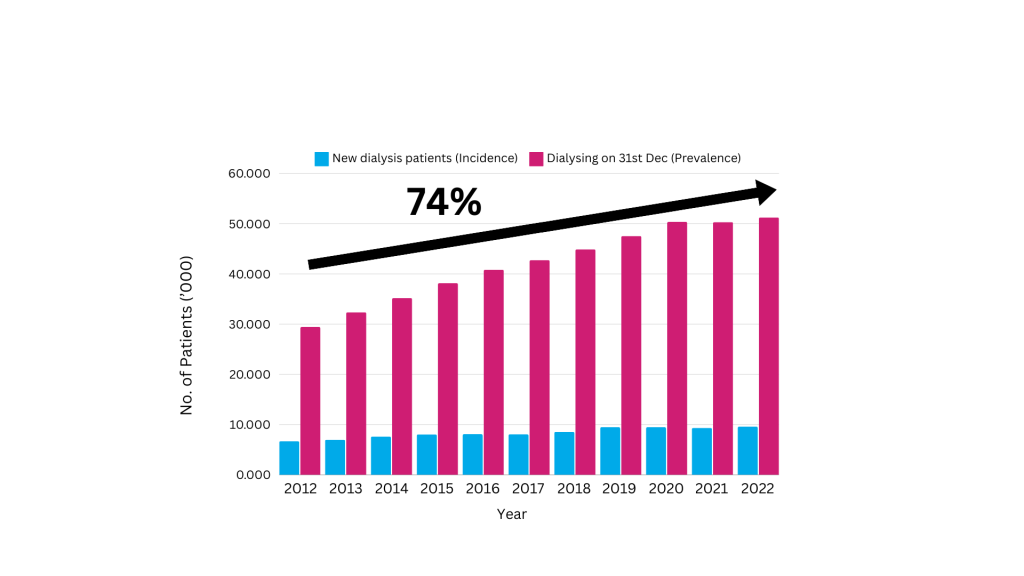Chronic kidney disease (CKD) is a common and debilitating condition that affects around one in 10 people worldwide, and its prevalence is increasing1.
By 2040, CKD is set to become the fifth leading cause of death globally, with a staggering 90 per cent of sufferers unaware of their condition2, 3.
People living with CKD progressively lose kidney function but may not know they even have the disease until the later stages4.

The scenario in Malaysia is particularly alarming, with more than five million individuals living with CKD, and the number of dialysis patients climbing each year8.
Despite its growing prevalence, CKD remains neglected on the global health stage, often going unnoticed until reaching advanced stages – a situation of grave concern, especially in areas like ours where 15.5 per cent of the population is affected5.

The Escalating CKD Challenge In Malaysia
The economic impact of CKD in Malaysia is significant, with public sector expenses on end-stage renal disease (ESRD) hitting RM1.12 billion in 2016 – an increase of 94 per cent in just seven years10.
Even more alarming, a significant portion of health care spending goes into dialysis, sidelining crucial preventive measures and early treatments.
This spike in expenditure versus overall health spending sends a critical alert to authorities regarding the sustainability of the current ESRD funding approach and the urgent need for comprehensive preventive strategies.
The early identification of CKD is crucial; yet its true value is realised through timely and effective interventions that decelerate the disease’s progression.
The advancement of technology has brought forth a range of innovative medicines and treatments that could support the treatment of CKD.
However, we should continue to address fundamental factors, such as diabetes and hypertension, as advancements in treating these areas could potentially prevent the onset of CKD.

Moreover, CKD should not be viewed in isolation due to its interconnected nature with other conditions, notably as a ‘disease multiplier’.
For instance, approximately 40 per cent of individuals with heart failure also suffer from CKD. Similarly, individuals diagnosed with both diabetes and early-stage kidney disease typically experience a decline in life expectancy when compared to healthier counterparts.
This interconnectedness underscores the need for a holistic approach to managing CKD, one that involves addressing the broader spectrum of related health conditions.
AstraZeneca’s Vision For Revolutionising CKD Care
At AstraZeneca, our mission goes beyond merely treating diseases; we aim to prevent them, envisioning a future where conditions like CKD are a thing of the past.
We consider ourselves a central part of the health care community and are committed to working with the entire kidney community – patients, HCPs, policymakers, industry leaders and more – to transform CKD delivery and care.
We have set forth ambitious goals to aid the screening of 140 million individuals at risk of CKD worldwide by 2025, striving to transform kidney health and cut the rate of patients progressing to kidney failure by 20 per cent.
These objectives are underpinned by collaborations with essential health care stakeholders and policymakers.
As part of this vision, we have launched the Accelerate Change Together (ACT) on CKD programme in Malaysia, backing the national agenda to overhaul kidney health.
We are also strengthening our ties with health care providers by collaborating with entities such as the Malaysian Society of Nephrology (MSN), the National Kidney Foundation (NKF), Malaysian Medical Tweet Association (MedTweetMy), and key laboratory partners.
These partnerships are aimed at boosting CKD awareness, screening standards, and ensuring earlier diagnosis and appropriate early intervention.
Embracing Digital Innovations For Enhanced CKD Management
In 2023, we took a step forward by partnering with the Malaysian Society of Nephrology to co-create the MyCKDCPG web application. This digital innovation serves as a cornerstone to improve CKD management among Malaysian primary care physicians, offering an interactive version of the CKD Clinical Practice Guidelines (CPG), along with added management features which includes the Kidney Failure Risk Equation (KFRE), a tool for predicting CKD progression based on critical parameters.

Looking ahead, we plan to expand this CKD predictive tool to support physicians to risk stratify patients seamlessly, thus optimally improving patient care.
Only 5 per cent of people with CKD are aware that they have the disease. To empower Malaysians and support the government’s effort in improving CKD care and management, we are also working towards integrating the CKD assessment tool into MySihatPal, our web-based education portal.
All of our effort reflects AstraZeneca’s global initiative ‘Make the Change for Kidney Health’, an initiative aimed at advocating early diagnosis and optimal treatment to reduce the burden of CKD on individuals, health care systems, and society in conjunction with World Kidney Day 2024.
A Call For Collective Action
When it comes to CKD management, the consequences of inaction are severe. Health care costs are soaring, patient quality of life is deteriorating, and the burden on caregivers is intensifying.
Addressing the challenges of CKD demands a collective effort; The Ministry of Health has invested heavily within this CKD space including early screening initiative among higher risk populations which is reflected from multiple initiatives such as PekaB40 and Agenda Nasional Malaysia Sihat.
We are committed to collaborating with stakeholders throughout the health care ecosystem to develop innovative solutions that address patient needs, emphasising the critical role of patient empowerment in this journey.
We remain steadfast in our commitment to transforming CKD and won’t rest until we have achieved sustainable change for patients all over the world.
Together, we can reshape the landscape of CKD care, securing a healthier future for all Malaysians.
References:
1Saminathan, T.A., Hooi, L.S., Mohd Yusoff, M. et al. Prevalence of chronic kidney disease and its associated factors in Malaysia; findings from a nationwide population-based cross-sectional study. BMC Nephrol 21, 344 (2020). Last accessed: 21 March 2024. Retrieved from: https://doi.org/10.1186/s12882-020-01966-8.
2Vanholder R, Annemans L, Bello AK, Bikbov B, Gallego D, Gansevoort RT, Lameire N, Luyckx VA, Noruisiene E, Oostrom T, Wanner C, Wieringa F. Fighting the unbearable lightness of neglecting kidney health: the decade of the kidney. Clin Kidney J. 2021 Apr 20;14(7):1719-1730. doi: 10.1093/ckj/sfab070. PMID: 34221379; PMCID: PMC8243275. Last accessed: 21 March 2024. Retrieved from: https://www.ncbi.nlm.nih.gov/pmc/articles/PMC8243275/
3GBD Chronic Kidney Disease Collaboration. Global, regional, and national burden of chronic kidney disease, 1990-2017: a systematic analysis for the Global Burden of Disease Study 2017. Lancet. 2020 Feb 29;395(10225):709-733. doi: 10.1016/S0140-6736(20)30045-3. Epub 2020 Feb 13. PMID: 32061315; PMCID: PMC7049905. Last accessed: 21 March 2024. Retrieved from: https://pubmed.ncbi.nlm.nih.gov/32061315/
4National Kidney Foundation. Chronic Kidney Disease (CKD). Signs and symptoms. Last accessed: 21 March 2024. Retrieved from: https://www.kidney.org/atoz/content/about-chronic-kidney-disease
5Kidney Care UK. An estimated 1 in 10 people worldwide have chronic kidney disease. Last Accessed: 21 March 2024. Retrieved from: https://www.kidneycareuk.org/news-and-campaigns/news/estimated-1-10-people-worldwide-have-chronic-kidney-disease/
6Wang H, et al. Lancet 2016; 388:1459-544
7NIH. The global burden of kidney disease and the sustainable development goals. Last Accessed: 21 March 2024. Retrieved from: https://www.ncbi.nlm.nih.gov/pmc/articles/PMC5996218/
8Galen Centre For Health And Social Policy. Malaysia Is On The Brink Of A Kidney Disease Crisis. Last accessed: 21 March 2024. Retrieved from: https://codeblue.galencentre.org/2024/03/14/malaysia-is-on-the-brink-of-a-kidney-disease-crisis-galen-centre-for-health-and-social-policy/
9Loke Meng, Ong, Sunita, Bavanandan, Lai Seong, Hooi, Cheh Loo, Choo. 30th Report of the Malaysian Dialysis and Transplant Registry 2022. Last accessed 21 Mar 2024. Retrieved from: https://www.msn.org.my/nrr/wp-content/uploads/2023/09/Chapter-2-Dialysis-in-Malaysia-2022_ong-edit_20230901_v4_Cleaned.pdf
10Ismail H, Abdul Manaf MR, Abdul Gafor AH, Mohamad Zaher ZM, Ibrahim AIN. Economic Burden of ESRD to the Malaysian Health Care System. Kidney Int Rep. 2019 May 29;4(9):1261-1270. doi: 10.1016/j.ekir.2019.05.016. Erratum in: Kidney Int Rep. 2019 Dec 03;4(12):1770. PMID: 31517145; PMCID: PMC6732754. Last accessed: 21 March 2024. Retrieved from: https://pubmed.ncbi.nlm.nih.gov/31517145/
11National Health and Morbidity Survey 2019, Institute of Public Health, Ministry of Health Malaysia
1226th Report of the Malaysian Dialysis and Transplant Registry 2018
Approval code: MY-13922_MAR2024
This article is the personal opinion of the writer or publication and does not necessarily represent the views of CodeBlue.





